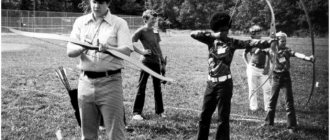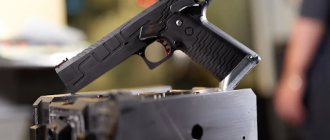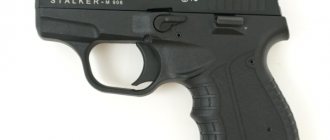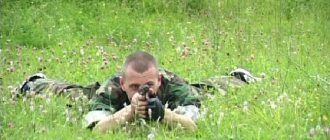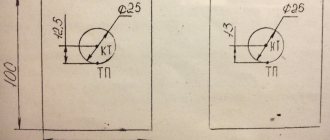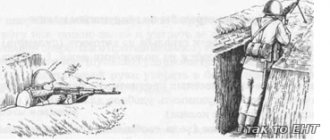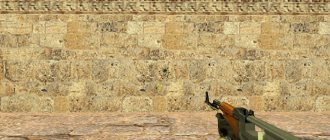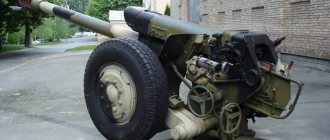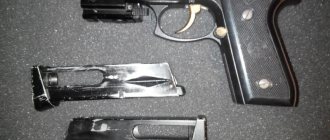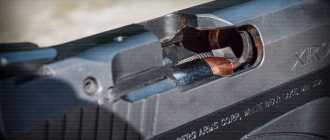Since its introduction, the pistol has become the most accessible individual firearm that can be used for both self-defense and offensive purposes. The ability to wield a weapon determines the subsequent effectiveness of using a pistol for various purposes. In parallel with the improvement of weapon design, pistol handling skills were improved. Over time, to improve the skill and skill of using weapons, various training methods appeared, which formed the basis for the study of technology and tactics. One of the main elements of shooter training is practical training, during which pistol shooting training is conducted.
Shooting training can be conducted in different conditions, both for applied purposes and for the purpose of improving combat skills. Interest in firearms has become the main argument, due to which the ability to shoot correctly and accurately becomes not only a professional necessity.
Many people love to shoot. For some, this may just become a hobby, but for others, practical pistol shooting becomes a path to the big sport. Bullet shooting competitions can easily be called the most spectacular and exciting. Athletes compete in their ability to quickly and accurately hit targets at different distances. Exercises during competitions must be verified and polished. Success can only be achieved if the athlete accurately and correctly completed all approaches, managed to accurately hit all the intended targets, while avoiding gross tactical and technical miscalculations.
Pistol shooting
Despite the fact that sports shooting is based on the same rules and requirements for handling personal firearms, combat shooting from a pistol has fundamental differences. Here it is important not only the shooter’s ability to hit the target accurately, but also combat tactics and the shooter’s actions depending on the current situation. The ability to correctly take a shooting position, the ability to fire to kill from any position, while maintaining a high rate of fire, are key safety factors for the shooter.
Where and how can you learn pistol shooting in the Russian Federation?
After the Decree came into force in 1918, ordering the population to hand over ammunition and weapons, civilians could only have self-defense weapons for personal use. Another option for pistol shooting training is shooting sports.
Shooting training
Self-defense weapons
Officially, the law on weapons (Article 3) allows traumatic and gas pistols, and flash-noise cartridges. Of these options, only “traumatic weapons,” officially called weapons of limited destruction, are suitable for training at home, so the pistol shooting technique must be honed to perfection.
Traumatic pistol
The algorithm for obtaining permission to purchase, store and use a pistol is as follows:
- visiting a special school - specialists will cover legal aspects in 4 hours of theory, followed by practice, passing an exam of 10 questions (1 mistake is allowed) and practice shooting, the service costs about 5,000 rubles, a certificate and act are issued;
- paid medical examination - 4 doctors, 2 of them in a clinic (about 1,500 rubles), a psychiatrist and a narcologist in specialized dispensaries (another about 1,500 rubles);
- CTI analysis (urine) - separately from the previous paragraph, although the conclusion fits into the narcologist's column;
- buying a safe is a global practice that ensures the safety of storing weapons and the procedure for their use, the purchase budget starts from 2000 rubles;
- visit to the local police officer - a representative of the Ministry of Internal Affairs checks the safe and issues the corresponding report free of charge;
- license department - at the time of visiting the user must have an account on the government services portal; after submitting documents, the review period is 4 weeks maximum (in practice 1 - 2 weeks);
- purchase of weapons - after obtaining a license, you can buy a pistol and ammunition for it.
License for traumatism
These steps allow you to buy a high-quality replica of a military weapon that shoots gas or rubber balls.
MMG Mauser
Attention: There are mass-sized mock-ups of MMGs, from which it is impossible to fire a shot in principle. They do not require permission, but they are an ideal option for home training (grabbing, carrying, snatching, leaving the line of fire, stances, etc.).
Sports shooting
By default, in the Russian Federation, sports shooting is regulated by a set of rules that, in principle, have no age restrictions. In practice, ranks must be periodically confirmed; in free sections, the trainer is reluctant to waste his time on “unpromising” students. However, this is the least labor-intensive way to shoot a military weapon. According to the rules of bullet shooting, there are two types of Olympic sports competition:
- pneumatic pistol – exercises PP1, PP2 and PP3 for all athletes;
- small-caliber pistol - exercises MP-6 and MP-8 for men, MP-5 for women.
Air pistol shooting
Shooting from a small-caliber pistol
In non-Olympic shooting, exercises with a center-fire revolver are added to pneumatics and small-caliber pistols.
Training Nagant
Practical shooting
Since 2006, branches of the Practical Shooting Federation have appeared in most regions of the Russian Federation. This is one of the most expensive sports types, since ammunition and weapons are purchased by the athlete himself after obtaining a permit and obtaining a license.
Practical shooting competitions
Officially, practical pistol shooting is recognized as the most spectacular type of competition, since official exercises here are used exclusively for the qualification of the participant. The competitions themselves are held in a constantly updated target environment with changing performance conditions and sets of obstacles.
Variant of the target environment in practical shooting
Team and individual training in practical pistol shooting is conducted at specially equipped shooting ranges of the branches of the FPSR Federation. To achieve high results, you must have at least a traumatic pistol and an MMG.
In applied types of sports confrontation pentball, airsoft and other airsoft, models of automatic weapons are usually used, not pistols.
Basic Gun Safety Rules
When handling any firearm, the following basic rules must be strictly observed:
- The weapon is considered always loaded until it is possible to verify the opposite personally.
- You should always hold the weapon in the safest direction - the barrel should only be pointed at the target you are going to shoot at.
- The index finger should be outside the trigger guard. Exception: when the shooter looks at the target through the sighting device.
- Before you pick up a weapon, you need to study its technical characteristics and features.
- The weapon must be stored in a safe place that will prevent its unauthorized use by others. Weapons and ammunition are stored separately.
- Only pick up a weapon when sober.
Training order
The algorithm for obtaining practical skills in using weapons is as follows:
- getting used to the gun and holding it with one or two hands;
- studying stances and techniques for quickly drawing weapons;
- a set of training exercises for aiming and firing;
- shooting from a combat pistol from racks at various distances;
- movements and actions to leave the line of fire;
- firing while moving.
Classes at the shooting range
First, sports exercises are mastered, then the practical direction of handling a pistol. At the last stage, the basics of a tactical nature are mastered. The main differences between combat shooting and sports and practical shooting are:
- bullet shooting competitions require high accuracy of hits;
- for practical shooting competitions, you first need to pass the standards, then the speed of performing the exercises;
- in combat duels, the main task is to survive, so shooting begins with leaving the line of fire, the movement does not stop until the enemy is physically destroyed.
Sports revolver shooting
Practical pistol shooting
Combat shooting on the move
Instructors pay special attention to psychological aspects and teach the student to control the consumption of ammunition. Only in combat shooting is firing from the hip, offhand and in motion, “swinging the pendulum” and other feints used that make it difficult for the enemy to aim fire.
Theory and incomplete disassembly
It is necessary to know the design of a weapon, if only because it needs to be reloaded and regularly cleaned and lubricated. Complete disassembly is used extremely rarely; the correct partial disassembly of a PM pistol is usually mastered. It is not recommended to start shooting practice with submachine guns and modifications with the ability to fire in bursts (Stechkin, Mauser). The design of the pistol looks like this:
- the frame with a hinged trigger guard is the power frame of the weapon;
- all other parts are removable;
- if disassembly is incomplete, remove the magazine, bolt and mainspring;
- the coiling of the spring is not symmetrical, it is put on the barrel from the side of the smaller diameter, as if screwing along a thread;
- When assembling, the shutter is slightly raised with its back side up and placed on the trigger mechanism with an energetic movement.
Incomplete disassembly of PM
All techniques and rules for shooting a pistol directly depend on its design. For example, if the weapon is not self-cocking, when the thumb of your strong hand is removed, the safety is removed, and the second hand moves the bolt to the rear position, chambering the cartridge in the firing position.
Distances for working with a pistol
By default, a pistol in the army is considered a personal weapon, not a small arms weapon. This is the last argument before hand-to-hand combat, and the ammunition is very limited compared to automatic weapons. In other words, in a combat situation, a pistol is part of self-defense, allowing you to survive, but in sports and practical shooting, on the contrary, targeted and high-speed shooting from a pistol is more important.
Hidden Weapon Detection
There are four distances with varying degrees of effectiveness for a fighter armed with a pistol:
- short – perimeter within two steps;
- close – radius 2 – 6 steps;
- medium – zone 6 – 12 steps to the enemy;
- farthest - 9 - 12 meters from the defender.
For short distances the following nuances are characteristic:
- severe stress to the point of stupor;
- there is not enough time to draw the pistol;
- Melee weapons are considered more effective.
Thus, training sessions should reinforce on a subconscious level an increase in distance when an enemy is detected 2 steps away from you.
Close distance is considered no less dangerous for a number of reasons:
- a knife and other bladed weapons remain quite effective at this distance;
- you need to shoot either while moving or after breaking the distance;
- An inexperienced defender is faced with the question of whether to shoot.
At close range, the subconscious often switches to a sports type of thinking. A static stance is adopted, the defender becomes fixated on drawing the weapon, forgetting about movements.
The middle distance is most convenient for a psychologically prepared shooter:
- enough time to determine the hostile intentions of the opponent and draw the weapon;
- no delays in movement, no tunnel vision effect;
- even when shooting from the midline of the body or from the hip, the defender confidently hits the target.
Long range is already a sporting type of bullet shooting; in practice it is rare. Ideal for pendulum techniques and two-gun low acrobatics.
Holding a weapon (grip)
Before developing the correct grip, you should start by practicing getting used to the weapon. Effective combat pistol shooting is only possible with the correct grip. The hand in which the weapon is located is called “strong”, the second, accordingly, “weak”. At the initial stage, it is recommended to train holding with two hands:
- the weapon fits into the palm of a strong hand;
- held by two fingers - the thumb from the inside, the middle one from the outside by the handle under the trigger guard;
- the little finger helps shape the position of the hand, but does not participate in the grip; it lies on the handle freely, without pressure;
- The ring finger is involved in the grip and lies on the handle.
Proper weapon holding
The butt plate of the pistol should be firmly seated in the groove of the hand between the thumb and index finger in both the horizontal and vertical directions. Grip strength is developed by exercise with the ball.
Fitting the butt plate into the fork
Then the same exercises are repeated for the weak arm. After this, the weak hand is connected to the “Two-handed” grip:
- she hugs the hand of a strong hand with a weapon;
- the thumb is located in front of the thumb of the strong hand in a similar position;
- the bent index finger supports the trigger guard from below.
Grab with both hands
Since delays in pistol shooting most often occur due to correcting incorrect holding, you should consolidate the last exercise with a partner and develop the technique.
Drawing a weapon
The easiest way to start drawing a pistol correctly is to master the exercise from behind the belt:
- the hand of a strong hand is formed into a “fork”;
- lightly hits the buttplate of the pistol;
- simultaneously grabbed with the middle and thumb;
- pulled out from under the belt.
Capturing the buttplate in the fork
Putting you in the line of fire
After a week of daily exercise, a speed type of draw is formed from a waist holster, then, if necessary, from an underarm holster. When following commands when firing a pistol, the draw is the initial movement.
The correct trajectory for drawing a weapon
Since in combat conditions you will have to fire from a Makarov pistol from different positions, the technique should include drawing the weapon while sitting on a chair, lying on your back, stomach and side.
Wrist workout
By default, the muscles of the hand and wrist form a “corset”, the strength of which determines the spatial position of the weapon at the time of the shot. It is necessary for the trainee to perform the following exercises to improve wrist strength:
- writing out figures or letters of the alphabet with the end of a long stick held in the hand;
- holding the weight in an outstretched strong, then weak hand;
- winding a rope with a suspended load alternately in different directions with the hands;
- push-ups on wrists and fists.
A set of exercises for the wrist muscles
Since in combat conditions they shoot not from a static stance, but in motion, and the weak hand is often occupied with other things, the wrists must be trained, and their muscle tone must be maintained by regular exercise.
Trigger processing
It’s easier to spend a week of time (half an hour of practice every day without breaks) than to burn cartridges trying to correct mistakes when performing shooting. For this purpose, an educational and developmental device is used:
- a paper cone 7–10 cm long is placed on the index finger placed on the trigger of the pistol;
- it is necessary to achieve smooth movement of the sharp end of the cone when selecting a free stroke and firing a shot.
Smooth descent training
The main mistake of shooting cadets is “waiting for a shot.” The finger tenses too much, pulls the trigger, the bullet has an unpredictable trajectory.
Racks
The most convenient position is a frontal stance when shooting a pistol with two hands. However, in real conditions it is necessary to conduct a duel with one hand or fire from two pistols, so the sequence of studying all types is discussed below.
Options for pistol shooting positions
For two-handed shooting
One stance is suitable for more effective performance of combat missions - the front one:
- the student stands facing the target;
- slightly bends the legs to absorb recoil and allow free movement in any direction;
- hands with weapons rise to shoulder level;
- the elbow of the strong arm is directed straight down, slightly bent;
- the elbow of the weak arm is slightly turned inward;
- the body leans forward to move the center of gravity closer to the tips of the toes.
Front stand
The basic rule is that in the projection of the shooter from above onto the ground, the arms and torso form a triangle.
For one-handed shooting
Take a stance for firing with one hand as follows:
- you need to stand sideways to the target, with a strong hand towards it;
- the toes of the feet are slightly spread in a natural, most comfortable position;
- both hands are raised to shoulder level, their position is selected to be as comfortable as possible for the shooter;
- then the weak hand lowers, and the strong one turns towards the target.
One-handed firing position
In this stance, called dueling, the silhouette is reduced by 50% compared to the frontal position. It is more difficult for the enemy to hit the cadet; the most important organ - the heart - is protected by the body by default.
For shooting with two pistols
Due to anatomical features, a person is not able to simultaneously aim from two pistols, therefore the classic frontal stance for firing with two hands with minor additions is considered the most effective:
- the weak hand does not support the strong hand, but provides a grip on the second weapon;
- The rigidity of the two pistols is ensured by pressing the thumbs against each other.
Grip two pistols for two-handed shooting
Thus, firing two barrels doubles the firepower. However, as an exception, there are options for firing from two pistols that solve a specific tactical problem.
When training, it is necessary to observe safety measures - the barrel of the pistol should always be pointed towards the target, when turning, the weapon tilts towards the ground and moves along the body.
Which pistol should you choose?
§ 32. Techniques and rules for shooting small arms
During training and competitions, various models of pistols are used. The available sports pneumatics are distinguished by a variety of models. The choice of the appropriate one should be in accordance with the shooter’s preferences and the recommendation of the coach.
There are several signs that athletes pay attention to when choosing a sports pistol:
weight - should not be more than one and a half kilograms; handle shape - should fit comfortably in the hand and not slip; behavior during shooting - since pistols fire bullets at high speed, it is important that the design of the weapon dampens shocks; presence of a sight; trigger mechanism - it is important that the adjustment is as simple as possible.
Each sporting pistol must be accompanied by instructions so that a beginner can understand the weapon without the help of a trainer.
Combat shooting
After studying the sports course, you need to consider the following factors:
- It is better to exercise in casual clothes, using a minimum of special equipment, devices and ammunition;
- combat shooting from a pistol with a “weak” hand increases the effectiveness of wielding a weapon with a “strong” hand by at least 30%;
- Each shot should be analyzed after practice.
Life depends entirely on movement, so movements must be smooth, but continuous, with a trajectory unpredictable for the enemy.
The Makarov pistol
This weapon was developed in 1948 in connection with the requirement of the USSR army to create a pistol for officers. It differs from its predecessor in being safer, more compact and with a stopping power of the bullet. To achieve this goal, a 9 mm cartridge was first created.
In addition to Russia, the PM pistol was produced under license in Germany, China and Bulgaria. During the period of weapon production, the manufacturability of production was significantly improved. Also in Tula in the 1960s, work was carried out to lighten the pistol by creating a frame made of plastic and light alloys. This option showed fairly good results, but was not adopted.
Tactical shooting
In practical shooting classes, there are ready-made schemes and procedures for hitting several targets. For a combat training course in shooting rules, this approach is unacceptable for a number of reasons:
- The diagrams include the static position of the athlete, that is, in a real combat situation, this is a direct stand for the enemy’s shot;
- targets in competitions are stationary, real opponents can move every second using pistols as a team.
Scheme of hitting targets from an ambush
Tactical shooting uses a different principle of analyzing targets and the order of their destruction - the closest enemy is most dangerous. Combat tactical movement training should be carried out after sports shooting training, when the standards have already been passed. In order for shooting training to be guaranteed to bring results, it is necessary to pay attention to the psychological preparation of the fighter.
Thus, you can learn pistol shooting in several ways, depending on the tasks being solved. Sports and practical shooting competitions are regularly held. Combat shooting is available to citizens of the Russian Federation only from a traumatic pistol for self-defense.
How to shoot from a PM correctly?
To develop shooting skills, many people choose a shooting range. However, it is not often possible to find a site that is optimally sized. It will be especially difficult for novice shooters who are distracted by other people or observers. Before using a weapon, even an air gun, read the operating instructions and relevant legislation.
Since, of course, it will not be possible to learn how to shoot from a PM at home, you will need to find a suitable place for this. A large clearing where there are no other citizens or animals is suitable as a shooting range. It is advisable to start shooting after thoroughly stretching your joints and muscles. Surprisingly, it will help strengthen and make your arms and body more stable.
To be able to hit the target accurately, you need to feel the operation and features of the weapon, as well as navigate the distance to the target. For the pistol in question, it leaves no more than 15 meters. Having mastered shooting and accuracy at this distance, you can try success at long range.
Additional Tips
Shooting instructor tips
- When conducting a battle, you must not let your ammunition run out completely. Get used to this at the learning stage. When the number of bullets comes to an end, reload the magazine.
- To ensure timely protection or surprise attack, practice snatching the weapon from the holster in one sharp movement and instantly prepare to fire.
- Even when shooting very quickly, try not to pull the trigger thoughtlessly, and if you need an instant response, check the accuracy and speed of use of the weapon.
- Shooting a pistol in public places unless absolutely necessary is prohibited. Only designated areas may be used for training.
- To learn to shoot a pistol accurately, you need to constantly practice. If you fail, you can reduce the distance from the goal. Upon successful completion of training, regular training is required.
DETERMINING RESULTS
The shooting results of each participant in the competition are determined by the sum of points scored in the scoring series targets or by the sum of holes in the scoring targets. A hit on the waist target is counted if the hole is in the area of the figure or covers at least part of its border. A hole in a target with dimensional circles is considered to have violated the margin near which it is located, and is counted upward if it at least touches the outside of the dimensional line.
The assessment of a controversial hole is made using a template made of transparent material with circles printed on it. The outer circle is equal to the caliber of the weapon, the inner circle is the control circle (for alignment). The size of the template, equal to the caliber of the weapon, should be: for an assault rifle and a sniper rifle - 7.62 mm, 5.45; pistol - 9.00 mm.
If there are no measuring instruments, a violation of the contour line of the clearance line should be considered a break in its hole or the presence of a clearly visible trace of a bullet on the outside of the clearance line
The break in the clearance line by radial rays diverging from the hole is not taken into account. An oval hole from a bullet hitting the target at the moment of its appearance is counted if the length of the bullet hole does not exceed 12 mm when shooting from a machine gun, rifle and pistol
A combined hole (a bullet hitting a bullet) is determined and certified without removing the target from the shield by the KOR judges.
The presence and value of holes in the targets are determined by at least three KOR judges. If they do not have a unanimous opinion, the final decision is made by the senior judge of the CD. The decision of the panel of judges in assessing the merits of the holes is final and cannot be appealed.
Personal place in exercises performed on targets with dimensional circles is determined by the highest amount of points scored, and if they are equal, by:
more “10”, then “9”, “8”, etc.;
more points scored from a standing position, then from a kneeling position and lying down;
the smallest distance from the center of the worst hole in the last, penultimate and other targets.
Personal place in exercises performed on targets without dimensional circles is determined by the greatest number of hits on scoring targets, and if they are equal, the best shooting while standing, then - from the knee and prone.
In all cases not provided for by these Rules, you should be guided by the Rules of the shooting competitions of the Russian Shooting Union and the Regulations on the competition.
Samples of documents and protocols for conducting shooting competitions with standard or service weapons and general requirements for conducting military sports competitions are given in the Appendix.
Sports complex of the Military Hunting Society
Photo: sskvoo.ru
This is the oldest Moscow shooting complex today, the shooting range of which is located in the south-east of the city, in the picturesque Kuzminki forest park. Beginning shooters and Olympic champions train here, and amateur hunters hone their shooting skills before the opening of the hunting season. The sports complex has a round stand, a trench stand, a double trap, a sporting compact and much more.
st. Golovacheva, 2A
View on map
tel.
sskvoo.ru
